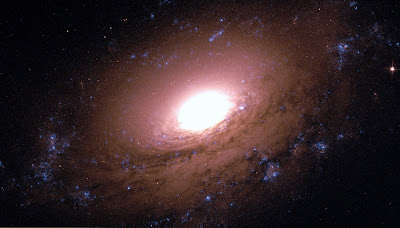Now we have an article in today's NYT about the Vatican Observatory that again reminds us that it does normal science:
But in the effort to rehabilitate the church’s image, nothing speaks louder than a paper by a Vatican astronomer in, say, The Astrophysical Journal or The Monthly Notices of the Royal Astronomical Society.There you have it. This is the experience of being at a modern astronomical facility. But there is one small difference. There is a dedication plaque that inevitably brings God into the equation:On a clear spring night in Arizona, the focus is not on theology but on the long list of mundane tasks that bring a telescope to life. As it tracks the sky, the massive instrument glides on a ring of pressurized oil. Pumps must be activated, gauges checked, computers rebooted. The telescope’s electronic sensor, similar to the one in a digital camera, must be cooled with liquid nitrogen to keep the megapixels from fuzzing with quantum noise.
As Dr. Corbally rushes from station to station flicking switches and turning dials, he seems less like a priest or even an astronomer than a maintenance engineer. Finally when everything is ready, starlight scooped up by the six-foot mirror is chopped into electronic bits, which are reconstituted as light on his video screen.
“Much of observing these days is watching monitors and playing with computers,” Dr. Corbally says. “People say, ‘Oh, that must be so beautiful being out there looking at the sky.’ I tell them it’s great if you like watching TV.”
“This new tower for studying the stars has been erected on this peaceful site,” it says in Latin. “May whoever searches here night and day the far reaches of space use it joyfully with the help of God.” At that point, religion leaves off and science begins.The question is, does this plaque affect their science? There is an ongoing debate going on over science & religion conflict or accommodation (see Jerry Coyne, Chris Mooney, Ken Miller, and just today, a thoughtful post from Sean Carroll). I will have a separate post on this stuff later. But here I wanted to address this question in light of science at the Vatican observatory. Vatican astronomers are certainly accomodationists and their papers are being published in peer-reviewed astronomy journals. Should we (as scientists) have a problem with their plaque and with their beliefs? As long as their science (not necessarily their whole worldview) does not bring in any supernatural assumptions and it goes through the standard peer-reviewed system - like any other work, it should be fine. Is it really a problem if they call their scientific observations, secondary causes?
The target tonight is three spiral galaxies — Nos. 3165, 3166, 3169 in the New General Catalog — lying about 60 million light-years from Earth, a little south of the constellation Leo. Sitting at a desk near Dr. Corbally is Aileen O’Donoghue, an astronomer from St. Lawrence University in Canton, N.Y., who is interested in how these gravitational masses tug at one another, creating the stellar equivalent of tides.
...
Back inside the control room she explains how the gravitational tides she is studying might be stellar nurseries. As one galaxy brushes by another, clouds of gas are stirred so violently that they give birth to stars.
Read the full article here. By the way, the article mentions that one of the objects they were observing that night was a spiral galaxy, NGC 3169. Hey - this galaxy is a friend from my thesis. I was also looking at star formation. I wonder if their results are different from mine - and if that is the case, is it because of the plaque? :)In the Vatican Observatory’s annual report, at the point where a corporation might describe its business strategy, is a section delineating the difference between creatio ex nihilo (creation from nothing) and creatio continua: “the fact that at every instant, the continued existence of the universe itself is deliberately willed by God, who in this way is continually causing the universe to remain created.”
Theologians call these “primary causes,” those that flow from the unmoved mover. Sitting atop this eternal platform is another layer, the “secondary causes,” which can be safely left to science.
Dr. Corbally and Dr. O’Donoghue continue working through the night, collecting data on secondary causes — galactic tides, stellar birth. Sleep will wait until morning, and thoughts about primary causes for another time.
Also, see this lecture by Vatican astronomer Father George Coyne. The Q&A at the end (the last half hour) wonderfully illustrates his position on science & religion.
Oh - and as a bonus, here is an image of NGC 3169 from the Hubble Space Telescope. This galaxy is located roughly 70 million light years away - and we are looking the light from a few hundred billion stars. You can also see very cool dust lanes in the galaxy. However, the blue clumps (mostly sitting on top of the dust lanes) identify places where young stars reside. The central part of the galaxy is all awash in yellowish light. This is the result of the combined light of about a hundred billion stars - so many that we can't see them individually. Enjoy!



1 comments:
I strongly believe or rather presume that science being the secondary cause would make facts ignored or not taken seriously just for the sanctity of primary cause/reason.
Post a Comment